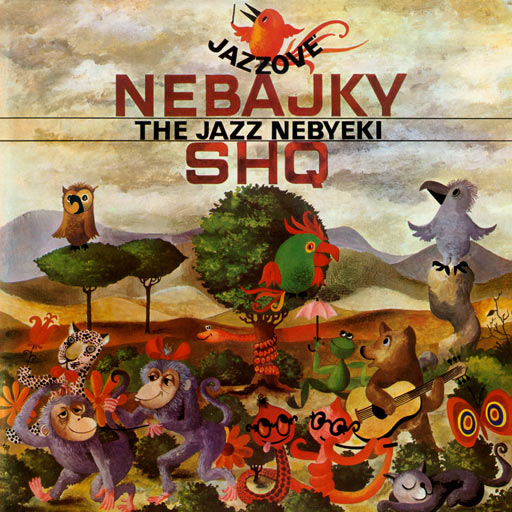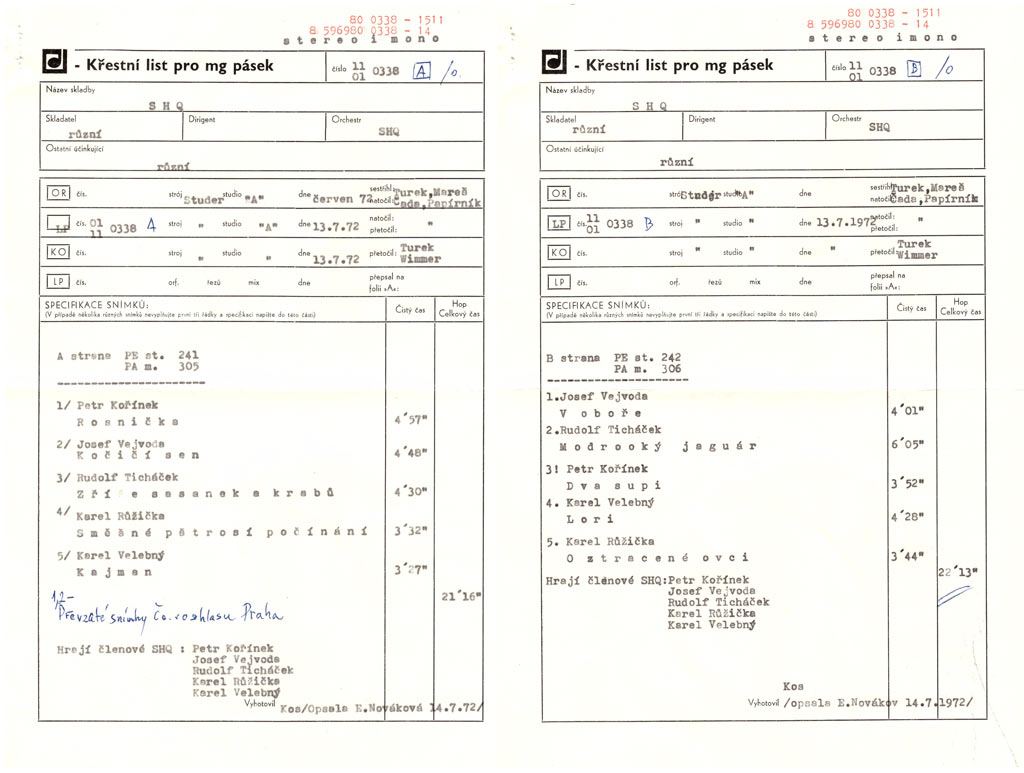SHQ – V oboře (In A Game Preserve)
From album “Jazzové nebajky” a.k.a. “The Jazz Nebyeki (Jazz Non-Fables)”, 1973, Panton 010338 (mono) / 110338 (stereo), reissued in February 2017 on CD Indies Happy Trails MAM735-2

Many jazz music writers have considered SHQ being among the most influential Czechoslovak jazz combos of all times. Already Lubomír Dorůžka and Ivan Poledňák have devoted a whole chapter to SHQ in their anthology Československý jazz – minulost a přítomnost (Czechoslovak Jazz – The Past And The Present, Editio Supraphon, Praha Bratislava 1967), an honor shared only with SHQ’s direct but relatively short-lived (1958–1961) predecessor Studio 5. And rightly so: in their early years and in context of their geographically limited sphere of activity, SHQ were a pioneering progressive jazz group, boldly exploring many previously undiscovered territories like the free jazz and the avant-garde, as well as – in their later years of existence – introducing several promising young musicians like Emil Viklický, František Uhlíř or Eva Svobodová to the broader jazz audiences.
SHQ was formed in summer 1961 by former Czechoslovak Radio Dance/Jazz Orchestra employees and Studio 5 members Karel Velebný (1931–1989) and Jan Konopásek (1931). Their goal was to establish a small professional jazz group, without being bound to any orchestra performing duties. Nonetheless, in communism even an independent jazz band was required to have an employer, and so for the first two years they became the staff band at the renowned Spejbl + Hurvínek Theatre (a.k.a. “Divadlo S+H”) in Prague, responsible for many scenic music recordings. The theatre also gave the group its name, albeit initially in various spellings: S+H kvartet, SH kvintet, SH Quartet, S+H Quintet, S+H Q, and many variants thereof. After a breakup and a temporary split into two separate “S+H” groups in the mid-1960s, Karel Velebný settled on “SHQ” for the most parts of his later career, adding further humorous name variants and spin-offs like “Sága rodu SHQ” (a wordplay: “The Saga of the SHQ Clan” but also “The Saxophones of the SHQ Origin”) or “Happy Music SHQ”.
After years of personnel fluctuation, by 1971 the lineup had become stable for the next three years: Karel Velebný on vibraphone and tenor sax, Rudolf Ticháček (1943–1982) on soprano and tenor sax, Petr Kořínek (1943) on double bass and Josef Vejvoda (1945) on drums. This quartet was subsequently joined by pianist and organist Karel Růžička (1940–2016). While their previous album Motus (Supraphon 1151138) from 1971 examined the wide possibilities of modal and partially free jazz, on the follow-up Jazzové nebajky, recorded in June 1972, the quintet began to absorb contemporary soul-jazz and jazz-funk trends. Especially compositions by Josef Vejvoda clearly broke with the formerly characteristic swinging and syncopated ternary rhythms and introduced straight and funky backbeats instead. (In a recent e-mail, Mr. Vejvoda confessed to me that his inspiration came, among others, from listening to Crusaders records back in the day.)
The album title was half-translated to English as “The Jazz Nebyeki”. It was likely meant to underline the funny and absurd wordplay of the Czech title, but the second subtitle on back cover is actually more precise: The Jazz Non-Fables. Both the Czech and the English track titles also remind us that this is a concept album: Hyla Viridis (a tree-frog), The Cat’s Dream, From The Empire Of Anemones And Crabs, The Comical Ostrich, Alligator Lucius, In A Game Preserve, The Blue-Eyed Jaguar, Two Vultures, Lori (referencing a parrot subfamily) a.k.a. Stenopes, and The Lost Sheep. The tracks were seamlessly joined by ambient noise interludes that additionally illustrate each respective topic. Not by actual animal sounds – mind you – but by their imitations, creatively and playfully performed by the band members themselves, as seen on credits like “decoy”, “cheeks”, “Stauffer’s lubricator”, “bowl of water”, “water pipe” or “newspaper”. Also, the album narrative was naturally adopted by Panton staff designer Aleš Striegl, allowing us to meet some of the subjects in person on front cover.
My pick V oboře is the opener of side two. The translation “In A Game Preserve” is a bit misleading for non-English speakers; we’re not in a realm for gambling but in a deer park. The life in a preserve is easy and monotonous but not dull, no rush either, enough food for everyone, live and let live. Composer Vejvoda kicks the tune off aptly with a relaxed funky drum beat, joined in by a simple on-the-one double bass and bluesy Hammond organ comping. One minute later, the saxes present a catchy theme that leads into a loose solo dialog between the tenor buck and the soprano doe, paraphrased from the other side of the panorama (unless you own a mono pressing) by the organ mouflon. The visitor’s path through the preserve is a straight one, no bends or windings, no harmony changes, this amusing excursion happens solely in the key of F.
The vinyl LP used to be quite a successful export article, regularly repressed and distributed abroad during the 1970s. It’s still an in-demand collector’s item, but the supply of well preserved copies at moderate prices hasn’t dried out yet. Nonetheless, saying that a CD reissue was “long overdue” is actually a massive understatement. Hey, we’re talking about a record that was voted the “best Czech jazz album until 1989” in a 1998 poll organized by the Czech Jazz Society! But for many decades it seemed as if this album has never existed. Literally, because since 2008 – since I was working on the Vampisoul compilation The Funky Way Of Emil Viklický that featured a couple of SHQ tracks – I have repeatedly asked about the fate of the album master tapes while visiting the Supraphon headquarters. Supraphon owns the Panton back catalog for quite some time now, yet Jazzové nebajky was nowhere to be found in their internal database! Frankly, I thought that to be quite disturbing.
But don’t despair, nebyeki aficionados! Thanks to the unyielding jazz enthusiast and bold label owner Jaromír Kratochvíl from Brno, not only have the original Nebajky master tapes finally resurfaced in 2016. On February 8, 2017, his label Indies Happy Trails has released the very first CD reissue of Jazzové nebajky. And that’s not the end of the good news yet. On seven other CDs, Indies Happy Trails has actually released the complete Supraphon recordings by Karel Velebný from 1959 until 1972, including the Hnilička & Velebný Tentet, as well as all Studio 5 tracks with several bonus tracks featuring Jan Konopásek and Iancsy Kőrössy that were out of print for more than a half of a century. The whole series was compiled and annotated by my fellow music writer, researcher and occasional collaborator Jaroslav Riedel.
Yours truly has also participated in the reissue project with additional research and discography facts. But mainly I was responsible for the remastering of four of the CDs, including Jazzové nebajky. (The other four CDs were remastered by Indies’ own engineer Broněk Šmid, albeit with my modest supervision, as he wasn’t familiar with the music yet.) Thus, although I haven’t witnessed the original Nebajky master tape in person – studio ADK-Prague did the “hi-res” digitalization to 24-bit/192 kHz – at least I can attest to have received the genuine audio material and to have carefully processed it following the (high, but admittedly my own) “A Loudness Peace Master” standard.
BUT:
Yes, it’s a big “but”, and that’s for a reason: Supraphon has simultaneously re-released the digitized SHQ recordings via their own supraphonline.cz digital music store (they can: their licenses to third party labels are non-exclusive). But the downloadable versions that Supraphon is selling are not the remastered ones! Trust me, some of the original unprocessed masters from the 1960s and 1970s sound actually pretty abysmal by today standards. Hence no link for now, avoid, and get the real thing on CD instead, approved by yours truly.
(P.S. Last but not least, the track V oboře will be also included on our upcoming Vampisoul compilation Czech Up! Volume 2 that is already in the works and scheduled for release later this year. Stay tuned.)

